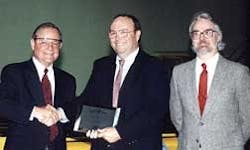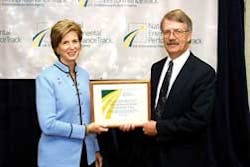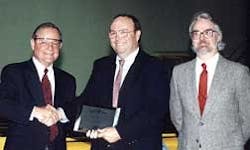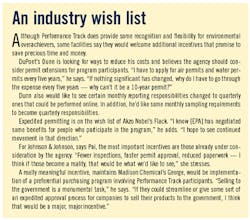Beyond Command and Control
Back in the 1970s ," the days of Love Canal, burning rivers, smoky skies and the energy crisis ," the "command and control" approach to environmental regulation seemed both appropriate and necessary. The U.S. Environmental Protection Agency (EPA) not only established compliance goals for long-polluting manufacturing facilities, but also dictated the technology or technologies to be used to accomplish these goals.
Industry needed such "blueprints" ," it generally lacked the incentive and know-how to clean up its own act.
Flash forward to the 21st century. The most horrendous of our nation's pollution problems are distant memories, and many experts believe we have reached a point at which incremental reductions in pollution too often require a substantial increase in associated control costs. Moreover, by sanctioning specific technologies for pollution control, existing regulations might not provide the necessary flexibility for a facility to achieve environmental improvements in a way that makes the most sense economically and logistically.
In other words, the one-size-fits-all approach to environmental protection no longer cuts the mustard.
EPA Administrator Christie Whitman welcomes Ray Krogmeier of DuPont's Fort Madison, Iowa, facility to the National Environmental Performance Track program.
Partnering for results
Even EPA is rethinking its tactics. Several recently launched agency voluntary programs now focus on results and the building of partnerships to help achieve those results.
EPA's Project XL, introduced in the mid-1990s, provides one example of the agency's willingness to try a new approach. Short for "eXcellence and Leadership," XL is a national pilot program that allows industry, state and local governments, and federal facilities to develop, in conjunction with EPA, innovative strategies to investigate better or more cost-effective ways of to achieve environmental and public health protection. In exchange, EPA provides regulatory, program, policy or procedural flexibility.
A few years back, the agency annou-nced another initiative called Community Based Environmental Protection (CBEP). Coordinated by the EPA's Office of Policy, Economics, and Innovation, CBEP supplements and complements the traditional environmental protection approach by focusing on the health of an ecosystem and the behavior of humans that live within that ecosystem, instead of concentrating on specific media or issues.
Perhaps most significant to industry, however, is EPA's newest large-scale voluntary program ," the National Environmental Performance Track program. Unveiled in 2000, the public/private partnership seeks to motivate and reward top environmental performers.
Dan Fiorino, director of the National Environmental Performance Track program, believes such voluntary programs enhance, rather than replace, traditional regulatory programs.
"I think regulation is still necessary to establish the basic rules of the game and keep everybody at least on the same basic level," stresses Fiorino, "but regulation sometimes has created barriers to improvements because there are very specific requirements that might not make sense at a facility. Also, they just add a lot of transaction costs."
Performance Track members earn the right to use the Performance Track logo within company communications and also receive national recognition from EPA through the agency's Web sites and various promotional materials. They are given the opportunity to participate in EPA information briefings, peer exchanges, workshops and networking opportunities. Participants also are of low priority for EPA inspection.
To qualify, program applicants must have in place a working environmental management system (EMS). The EMS must include a written environmental policy, a strategic plan to reduce environmental impact, and implementation and operation procedures to accomplish EMS goals, as well as methods to evaluate performance and to take corrective action related to nonconformance. Applicants must show a history of environmental compliance and achievement, as well as a commitment to continued improvement. In addition, they must have a public outreach program in place and actively report on their environmental performance.
EPA Administrator Christie Whitman speaks to National Environmental Performance Track members.
Making the grade
Such achievements are easier said than done ," only a small fraction of the nation's thousands of chemical, petrochemical and pharmaceutical facilities have demonstrated that they have what it takes for membership.
Madison Chemical Co. Inc. in Madison, Ind., is a charter member of Performance Track ," and a company that takes its environmental commitments very seriously. The independent, 82-employee specialty chemical manufacturer has won the Indiana Governor's Award for Pollution Prevention three times and aims to produce the most environmentally safe products possible.
"We design aqueous products to replace more environmentally dangerous products for cleaning and degreasing," explains Sam George, vice president and director of corporate affairs for Madison Chemical. "Anytime OSHA or EPA makes a list of bad things, we don't mess with them ," we stop using them. And that's a challenge. So whether it's a carcinogen or an ozone-depleting substance or a SARA 313 [substance], we design our products to help our customers eliminate those products in the first place."
Madison Chemical's environmental philosophy is driven by the company's owner, says George, and is carried out by every company employee. "We're competing for degreed chemists and chemical engineers, and we're in a little rural county in southern Indiana," notes George. "It's difficult sometimes to lure them here. But our environmental reputation and our commitment to these programs [allows us to] attract a certain type of employee that frankly we're looking for ," one who would rather do a lot of projects that really are very beneficial to the environment rather than say they work for a mega corporation somewhere."
One such employee is Madison Chemical chemist Marjorie Hare, says George. Awhile back, Hare became concerned about a certain chemical compound ," a potential endocrine disruptor ," listed as an ingredient in some of the surfactants the company used. "She evaluated new suppliers of the raw materials, got substitute surfactants, reformulated 35 of our products, eliminated every endocrine disruptor, improved the performance of the product and reduced the price," he notes. "We got an award for that."
Since 1997, Madison Chemical reduced biological oxygen demand (BOD) discharges to water by 45 percent through improved inventory control and slashed solid waste by 47 percent through recycling, better purchasing practices and installation of a permitted incinerator for certain types of nonrecyclable paper.
With 180 employees, Waukegan, Ill.-based Akzo Nobel Aerospace Coatings Inc. is another small, but mighty, charter Performance Track member. The facility, part of the Dutch company Akzo Nobel, manufacturers specialty paints, coatings and resins for the aerospace industry.
Hugh A. Flack Jr., director of health, safety, environment and quality systems for Akzo Nobel Aerospace Coatings' Waukegan plant, says the facility has always been "very proactive" in the environmental, health and safety areas. It has been actively involved in the citizens advisory group for the Waukegan Harbor since the early 1990s and is an ISO 14001-certified facility.
"We had planned to go toward an ISO 14001 program and, at the time, we did not think we'd do third-party certification, but instead self-assess against that standard," says Flack. "But we had started off in Illinois with a group called the Multistate Working Group [on Environmental Management Systems]. The Performance Track was a nice extension to that because they do highlight the ISO 14001 as a standard." The facility ultimately did decide to seek third-party certification of its EMS, adds Flack, a step that helped with Performance Track.
The Waukegan plant, since 1998, reduced its electrical use by 3.6 percent simply by closing off unused areas and shutting down power to them. In addition, facility employees cut hazardous waste by 28 percent by improving controls over waste disposal practices.
Of course, the chemical industry's top performers are not limited to small facilities. E.I. du Pont de Nemours and Co.'s (DuPont) Spruance Plant in Richmond, Va. ," DuPont's most "populous" plant, with some 2,500 employees ," has some bragging rights, too.
The Spruance plant, which essentially consists of six businesses manufacturing advanced fiber systems, films and nonwovens, is a recipient of the Virginia Governor's award for environmental excellence. Robert L. Dunn, the facility's community and environmental affairs manager, served as a mentor for Businesses for the Bay ," a Chesapeake Bay program. The site also is a member of the Habitat Recognition program and is an Exemplary Environmental Enterprise (E3) under Virginia's Environmental Excellence program.
According to Dunn, the Spruance plant reduced air emissions by 71 percent since 1987 ," while increasing production by more than 40 percent during the same time. Efforts involved leak detection improvements, training, equipment reliability improvements, the elimination of two lab solvents and other actions. The site also significantly reduced water use for cooling.
"Most all of what we've done has not had a significant cost impact," stresses Dunn, "because the objective is to take all the ingredients and turn them into product so you don't have any waste."
Noticing that the Performance Track performance criteria mirrored the actions it was already taking company-wide, New Brunswick, N.J.-based Johnson & Johnson ," a major manufacturer of health care products for the consumer, pharmaceutical and professional markets ," entered all 51 of its U.S. facilities into the program's application process. EPA subsequently selected all of the sites as charter program members.
Indiana Governor Frank O'Bannon (left) presents a pollution prevention award to Madison Chemical President Dick Goodman (center) and Technical Director Steve Hale.
Johnson & Johnson has a long history of environmental goal setting, explains Vivian Pai, the company's executive director for worldwide environmental affairs. In 1990, Johnson & Johnson developed a set of pollution prevention goals for all of its facilities across the globe. Those goals were exceeded and essentially put to rest in 2000, she says. To promote continuous improvement, therefore, the company developed a new set of objectives, referred to as its "next-generation" goals.
"It was at that time that the Performance Track came around," notes Pai. "Our mantra is beyond compliance,' so [the decision to apply for membership] was a no-brainer for us."
All Johnson & Johnson facilities are required to put into place an EMS such as ISO 14001, says Pai. "Not only that, our next-generation goals go one step further," she says. "Not only are all of our sites expected to have an EMS like ISO, they're also required to take that one step further and get third-party certification."
Since 1997 alone, Johnson & Johnson has cut energy consumption by 12 percent through improved management practices. It also has reduced packaging material use by 25 percent.
Committed to the future
Performance Track participants must do much more than document exemplary environmental achievements of the past. They also must commit to continuous environmental improvement ," setting concrete goals to be achieved within a specific timeframe.
On its Performance Track application, Madison Chemical committed to 32 percent and 34 percent reductions, respectively, in BOD discharges and solid waste. The company will use a combination of better inventory control, enhanced manufacturing processes, smarter purchasing and other actions to meet these objectives. However, admits George, the goals pose significant challenges.
"We just started our new wastewater treatment plant," says George. "I think that will drastically reduce our BOD, although this again is an example of our environmental policy. We do not have to treat the water any more than we already do. We can send it to the local POTW and just pay a BOD surcharge, which is what we've done for years. But we're going to meet the goals."
Akzo Nobel Aerospace Coatings' Waukegan plant said it would reduce volatile organic compound (VOC) emissions from wash tanks by 84 percent by cutting the number of solvent-containing parts washers and by using "greener" cleaners. It also committed to decreasing hazardous materials use, overall VOC emissions and electrical energy use.
Balancing the reductions with production increases poses the greatest hurdle, says Akzo Nobel's Flack. "The idea is to continue to increase production, increase efficiencies and try to minimize any additions of emissions, waste ," those key areas that we've worked so hard to try to reduce."
The DuPont Spruance plant pledged to increase the use of recycled Kevlar materials from 0 pounds (lb) per year to 180,000 lb per year by recycling prepolymers generated during process startups and shutdowns. In addition, the facility said it would cut air toxics, hazardous waste and solid waste.
"We're well on our way to meeting our commitments," maintains DuPont's Dunn. "Our annual [carbon disulfide] emissions were 50,000 pounds ," we said we'd take that to zero, and we've done that. We said we'd reduce nonhazardous waste in Kevlar, and we've cut that by over 90 percent already."
Johnson & Johnson's future commitments are based on the joint efforts of all 51 participating facilities. The company said it would reduce carbon dioxide (CO2) emissions by 2 percent by improving management practices and using alternative energy sources. It also committed to further reductions in raw material use, water use and solid waste generation.
"It is a big challenge," emphasizes Johnson & Johnson's Pai. "Because we've achieved so much already under our old goals, now it becomes harder and harder to achieve additional improvements."
And some reductions are more difficult to achieve than others, adds Pai. "For example, CO2 emissions ," that is the biggest challenge we have at the moment because our company is growing rapidly," she stresses. "This is a goal that measures absolute reductions. What we have done is tried to implement the use of more renewable energy ," for example, using solar energy, wind, hydroelectric power."
Reaping benefits
These super-achievers and other Performance Track participants have worked long and hard to achieve environmental excellence. They are quick to point out, however, the program's benefits.
"Performance Track has gotten us a lot of attention from government," says Madison Chemical's George. "One of our senators, Sen. Evan Bayh, dropped by the other day for photo opportunities and to announce some programs he's supporting. The commissioner of the Indiana Department of Environmental Management dropped by because they're very pleased with the way we conduct things. When you take these kinds of persons through the plant, it really makes an impression on the employees."
DuPont's Dunn said his facility also was values the recognition for its achievements. "I put myself in the shoes of the community, and I realized that if we are doing the things we're being recognized for and say we're doing, it's natural that we would be expected to be part of Performance Track," he says.
Johnson & Johnson's Pai sees the program as "that additional push, that incentive" the company needs to meet its next-generation goals. And, again, the formal recognition aspect of the program is a boon.
Program members also benefit from EPA-enabled information sharing, notes Julie K. Spyres, Performance Track's director for program development and member services. EPA holds an event each spring to allow members to share best practices and network. The event can be a golden opportunity for those seeking innovative solutions to persistent problems. In addition, EPA's regions host events in which program participants have "opportunities for a lot more dialogue in lieu of a presentation style," she adds.
What's next?
Performance Track is still a work in progress, and EPA is evaluating additional incentives that might one day benefit program participants. For example, the agency recently proposed one rulemaking that would allow hazardous waste generators within Performance Track to extend hazardous waste storage, and another that would reduce regulatory paperwork for Performance Track facilities.
And soon to be unveiled is a database of leadership practices, or best practices, says Spyres. "All of our members will be highlighted in that database," she says. "It's going to cover a lot of environmental best practices from all over the country that we learn about from different awards programs."
Also in the works is a mentoring program, notes Spyres. "Not only will it be for our existing members to mentor potential members," she explains, "but we're also going to use it as a way to try to link up our membership pool ," so they have a way of asking very specific questions for which they would like us to help find answers."
Moreover, the agency teamed up with the U.S. Occupational Safety and Health Administration (OSHA) to explore opportunities for joint workshops and other activities for facilities that are members of both Performance Track and OSHA's Voluntary Protection Program (VPP). The agencies also are looking into ways to recognize facilities that participate in both programs.
"We really want to use [Performance Track] to improve our ability at a facility and company level to measure environmental performance and to demonstrate that we can go from a very compliance-based approach to a performance-based approach," emphasizes EPA's Fiorino. "At some point, my hope is that we'll really start to build, with legal authority perhaps, some sort of a sharing approach to regulations ," where there are high performers who meet not a different set of performance expectations, but that EPA would sort of oversee and monitor differently, given their track record."
OK, so maybe Performance Track doesn't represent a complete turnaround in EPA's regulatory approach. But at least it's a start.
The next open application period for EPA's National Environmental Performance Track program begins on Feb. 1, 2003. For more information, visit www.epa.gov/performancetrack. CP




